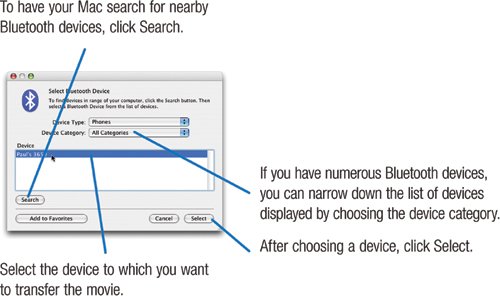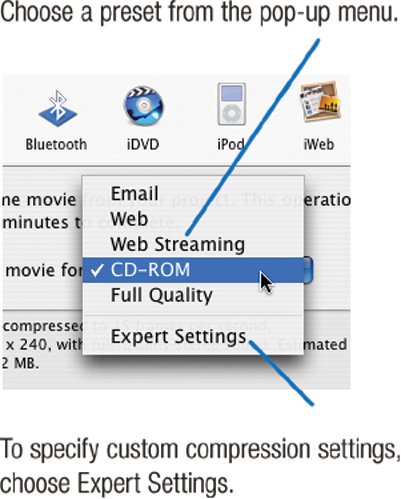More Ways to Share Movies
| Amid the police lineup of the Share dialog box are two buttons that represent iMovie HD's geekier sharing features. With the QuickTime button, you can export your project as a QuickTime movie. You might export a QuickTime movie in order to publish it on a Web site or burn it on a CD (page 276). Or you might want to email a movie to someone but use your own compression settings instead of those applied by iMovie HD's Email preset. With the Bluetooth button, you can transfer your movie to a cell phone or other gizmo equipped with Bluetooth wireless technology. An iPod is a better venue for a portable movie, but watching a movie on a phone is great geek fun. Just remember to switch off your movie theater when the aircraft is not stopped at the gate.
If you're using the Expert Settings option described at right, specify a movie dimension of 720 by 405 pixels (or a multiple thereof). Exporting a QuickTime Movie To export your project as a QuickTime movie, choose QuickTime from the Share menu, or press Shift- Expert advice. You can often improve on the picture quality provided by iMovie HD's Email, Web, and CD-ROM presets by using the Sorenson Video 3 compression scheme. To access it, hack through the following thicket of dialog boxes. In the Save dialog box that appears after you click Share, choose Movie to QuickTime Movie from the Export pop-up menu, then click the Options button. The Movie Settings dialog box appears; click Settings. In the next dialog box, choose Sorenson Video 3 from the pop-up menu. Now click OK several times to go back to safety. If you like, explore the rest of the Movie Settings dialog boxit's where you can specify the movie's pixel dimensions and sound settings. To learn about compression, see iMovie HD 6 & iDVD 6 for Mac OS X Visual Quickstart Guide, by Jeff Carlson (Peachpit Press, 2006). For more QuickTime resources, see www.macilife.com/imovie. Exporting to a Bluetooth Device Bluetooth is a wireless technology that connects devices over distances of up to about 30 feet. You can buy cell phones, printers, palmtop computers, keyboards, and mice that use Bluetooth's radio waves instead of cables to talk to each other and to the Mac. All current Mac models have built-in Bluetooth. If yours doesn't, you can add Bluetooth using a tiny and inexpensive adapter such as the D-Link Bluetooth USB Adapter, which plugs into any free USB port on your Mac. Mobile multimedia. Having Bluetooth is just one part of the mobile movie equation. Another part is a multimedia standard called 3GPP, which is supported by a growing number of cell phones and other gadgets. QuickTime supports 3GPP, too, and it's this support, combined with Bluetooth, that makes it possible to play a movie on a phone. To play a 3GPP movie, you need a 3GPP media player for your device. Two such players are Kinoma Player (www.kinoma.com) and RealNetworks' free RealPlayer (www.realnetworks.com/mobile). Making the transfer. Be sure your phone is on, then choose Bluetooth from the Share menu. In the Share dialog box, click the Bluetooth button, then click Share. iMovie HD compresses your movie, then displays a dialog box for transferring it.  Your phone may display a message asking if you want to receive the movie. Choose Yes. After the transfer is complete, navigate to your phone's messages menu, choose the new message, and watch the show. Tip iMovie HD saves the compressed movie on your hard drive; you can use Mac OS X's Bluetooth File Exchange program to transfer the movie again. Inside your movie's package file (see page 274) is a folder named Shared Movies. Inside that folder is a folder named Bluetooth. Your compressed movie is there; its name ends with the file extension .3gp.
|
- ERP Systems Impact on Organizations
- ERP System Acquisition: A Process Model and Results From an Austrian Survey
- The Effects of an Enterprise Resource Planning System (ERP) Implementation on Job Characteristics – A Study using the Hackman and Oldham Job Characteristics Model
- Healthcare Information: From Administrative to Practice Databases
- A Hybrid Clustering Technique to Improve Patient Data Quality

